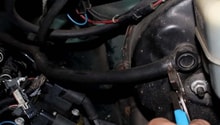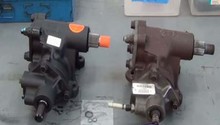Chevrolet Silverado 2007-2013: How to Replace Power Steering Fluid
Just because you steering wheel is getting hard to turn doesn't mean the rack is out. Maybe you just need to flush the old power steering fluid out of the system. This article teaches you how to do so.
This article applies to the Chevrolet Silverado 1500 (2007-2013).
Power steering, like most of the mechanical systems in a Chevy Silverado, uses a special hydraulic fluid to operate. The liquid is called power steering fluid, and is found in a reservoir located in the engine bay. When this fluid gets old, it will create deposits throughout the power steering system. The pump will have to exert extra pressure into the system to allow the deposit filled fluid to flow through it, which in turn causes the steering to be really loud. Over time, the dirty fluid can also damage the power steering pump. There are automotive shops that use flushing machines to replace the old power steering fluid; however, the process is fairly easy to do at home and can even save you a Ben Franklin or two.

Materials Needed
- Turkey baster
- Power steering fluid or Automatic Transmission Fluid (ATF)
- Pliers
- Shop rags
- Drain pan
- Jack
- Jack stand
Step 1 – Raise and secure the front of the truck
- Use a jack and raise the front of the truck.
- Support the front end using jack-stands.
(Related Article - How to Jack Up Your Truck - Chevroletforum.com)

Step 2 – Locate the power steering reservoir
Locate the power steering reservoir on your truck, it should have a cap with its name on it. Take a turkey baster and suck out some of the old fluid to check its consistency.

Figure 2. Locate the power steering reservoir. 
Figure 3. Old and new fluid.
Step 3 – Begin to flush the system
- Continue using the turkey baster to suck up any fluid from the system.
- Place the old fluid into a drain pan.
- Turn the steering wheel back and forth to pump more fluid into the reservoir.
- Suck up the rest the fluid from the reservoir.

Figure 4. Suck the fluid from the power steering reservoir. 
Figure 5. Place the old fluid in a drain pan or bottle.
Step 4 – Drain the rest of the fluid
There is still old power steering fluid in the lower lines. To drain this fluid, disconnect the lower pressure steering hose and let the fluid fall into the bottle or drain pan.

When the it stops flowing, pour more power steering fluid into the system. This will ensure the rest of the old fluid will drain out. Continue flushing the system until the fluid comes out clean.

Step 5 – Pour new power steering fluid
- Re-connect the lower pressure host to its fitting.
- Remove the jack stands and lower the truck.
Pour new power steering fluid into the reservoir and turn the engine on. Let it cycle for a few seconds and check the power steering fluid level, adding more if necessary. Then cycle the power steering from lock to lock a few times; this will help push out any air bubbles. Put the power steering fluid reservoir cap back on, and take the truck out for a spin. After about 20 minutes, check the fluid level again. If everything is fine, then you are finished!

Featured Video: How to Flush Power Steering System
Related Discussions
- Synthetic Power Steering Fluid - Chevroletforum.com
- Power Steering (Please Help...Losing My Mind) - Chevorletforum.com
- Help! No Brakes or Power Steering - Chevroletforum.com






